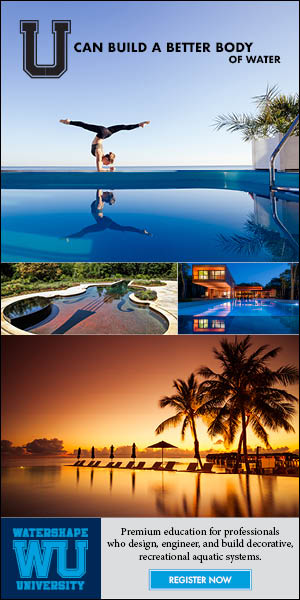construction
As I see it, there are six main types of watershapes: pools, spas, fountains, ponds, waterfalls and streams. Although there is tremendous variety within each category, I think most of us in the business would put pools, spas and fountains in one sub-group and ponds, waterfalls, and streams in another. Obviously, there's room for overlapping here - waterfalls installed with pools, for example, or fountains in the middle of ponds. The key distinction for me, however, is the closeness with which a pond, waterfall or stream must imitate
I've spent a lot of time in the past few years thinking about the things that generate the most interest in what we do as pool builders - and even more time turning those thoughts into designs and effects that meet my customers' desires. Once I started down this path, there was no way to turn back: There's a market out there at the high end that most pool builders never even approach, and breaking through with these clients takes persistence, skill and talent. As important, it also takes a willingness to stop looking at pools, spas and waterfeatures in the context of traditions and conventions that just don't line up with the needs or expectations that these customers at the highest levels have these days. These are customers who won't settle for the ordinary. They won't accept plans that stick
With just a few weeks to go before our work was to begin, I took my wife Denise to visit the historic pool at the Biltmore Hotel in Coral Gables. I wanted to take a long look at what was (and may always be) the largest re-plastering job I'd ever landed. As I stood at the edge of what can truly be described as a huge pool, I actually thought for the first time in my career that I'd bitten off more than I could chew: The surface of the massive U-shaped pool was in terrible shape and dragged down the hotel's otherwise beautiful decor and landscaping. Yes, it was the kind of prestige job I'd always wanted, but it only took a few minutes for the enormity of what I had undertaken to
One certainly emerges from all the discussions that have taken place about swimming pool plaster over the past several years: The product has had plenty of room for improvement. Among the complaints has been that traditional white-plaster pool finishes simply haven't kept pace with the rising expectations of owners, who increasingly want their pools, spas and waterfeatures to be entirely forgiving when their lifestyles limit the time they can spend on maintenance and upkeep. In that environment, in fact, traditional
All too often, the purchasers of a home (new or old) find a garden space stripped of any natural feel. Large lot or small, they sense no "connection" to the land - only a bleak space devoid of vegetation or any sort of overhead canopy and lacking the finishing touches that draw them out of the confines of the home to enjoy what usually represents the majority of their real estate. From my perspective, the best way to generate this connection to the land is through the creation of ponds, streams and waterfalls in these backyard settings. Such features bring a more natural look and feel to residential garden spaces and instill a sense of connectedness. And whether customers pick up this sense consciously or subconsciously does not matter: What matters is that they somehow know it, that they feel it. Plantings are a big part of this picture, but I lean heavily on watershapes to create connections because of
When I talk with prospective customers about hillside installations, more often than not I'll find myself saying "A good foundation deserves a great pool" at some point during our conversations. In fact, I view all of my pools as works of art, whether they're installed on a hillside or on flat land. The design can be a simple rectangle (which in my opinion are some of the most beautiful pools built) or an elaborate oceanscape with all sorts of bells and whistles. Regardless of location, style or complexity, I build my pools with first-rate foundations engineered for the specific soil conditions, and I give my clients the best pool I possibly can. As I explained in
As a former shotcrete builder myself, I believe you can't find a better method of building a pool, spa, pond or waterfeature of any type than by using pneumatically placed concrete, or "shotcrete." The method and the material offer the designer and builder great and often incredible design flexibility, and the resulting watershapes will last several lifetimes. Given that the vast majority of watershapers around the world depend on shotcrete as their primary construction material, it only makes sense that we should know as much as possible about putting this amazing product to its best possible use. Unfortunately, however, that's not always the case. There's little argument that the process of shotcrete construction is laborious and demanding, that it requires a major logistical and physical effort and that fairly precise timing is necessary. For all the focus it takes to apply it and shape it just so, however, I have observed a couple of critical steps many builders overlook in the press of getting the job done - the most important of them being the proper curing of the
How far we've come since the days of the lazy L, the kidney and the rectangle! During the more than 30 years I've been part of the pool industry, I've witnessed mind-boggling advances in the designs of swimming pools, spas and watershapes of all types. Especially in the past 10 years, the ideas, creativity and workmanship found in residential backyards far surpasses what we saw or even dreamed of 20 or 30 years ago. Back then, you'd have to go to a movie set or Las Vegas to see the exotic designs we are seeing today. I'd even say that today's designers are turning backyard pool environments into






















